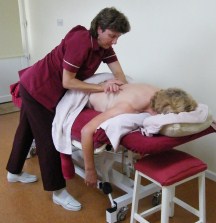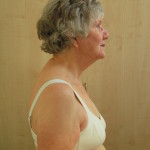Although I trained, to various levels, in the following forms of body work / physical therapies or manual therapy and techniques, I do not practice these as stand-alone therapies.
Body~Mind Coaching offers a seamless careful mix of therapies combined with mind healing approaches. I have found this to be much more effective than using each therapy on its own. This is because physical pain is often the last resort for the body, after it has sent other signs of dis-ease that have been ignored. The combination of treatments used is dependent on the problem which presents itself at each session as well as what you want to achieve.
Physical therapies / Bodywork /Treatments and techniques I use:
Remedial massage:
Remedial massage is also known as Swedish or therapeutic massage. Most people think of massage as a way to relax, but Remedial Massage is designed to do much more than that. It will help relieve pain from any type of injury just as physiotherapy, chiropractic treatment or osteopathy can do. Read more on my massage page.
 Orthopaedic massage:
Orthopaedic massage:
Orthopaedic massage involves therapeutic assessment, manipulation and movement of the locomotor soft tissue to reduce pain and dysfunction. Restoring structural balance throughout the body allows us to focus on both prevention and rehabilitation of musculoskeletal dysfunctions.
Position Release Therapy (PRT):
Positional Release Therapy is a gentle technique used for releasing muscle spasm in the body. The technique involves finding a tender point (muscles, ligaments, tendons and joints) and then moving the body part towards a position of greatest comfort.
This new position is held for about 90 seconds. Once the release is felt, you are taken out of the position and the tissues should be relaxed. The tender point should either be completely gone or 70% better.
After a successful treatment, you would experience decreased pain, muscle spasm, fascial tension and swelling, with improved joint mobility and postural alignment.
Myofascial Release:
The fascia, is like a continuous spider web suit. It surrounds and covers all your muscles, organs and bones, so the entire body is connected to every other part of the body by the fascia. Like in a sweater, damage or tension in an area of fascia can affect other distant areas in your body.
Fascia is the part that covers your muscles and defies their shape. In general Myofascial release is used to improve the health of the muscles and fascia, circulation and restore good posture.
Proper health of the fascia is restored by applying slow and sometimes deep pressure directly on the body. The pressure ranges from very gentle touch to deeper pressure, but is never beyond your tolerance, so it is important you give feedback to your practitioner during the treatment.
When Myofascia becomes too tight it can cause:
Headaches
Muscle pain and spasms
Chronic back and neck pain
Recurring injuries
Sciatica
Breathing difficulties
Sensations such as numbness and pins and needles
Poor posture and reduced flexibility
Things that can cause this once flexible tissue (Myofascia) to become too tight are:

- Traumas, such as a fall, sport, work or car accident
- Poor posture
- Lack of stretching such as prolonged sitting or standing
- Emotional/psychological stress
- Repetitive motions, such as factory work or keyboard work
The benefits of Myofascial Release therapy includes:

- Reduction in muscle spasms
- Improved joint movement
- Decreased muscle and fascial tension
- Improved breathing
- Myofascial Release can significantly improve many soft tissue and orthopedic conditions.
MET or Muscle Energy Technique and isometric stretching:
This hands on therapy technique involves a form of stretching designed to improve musculoskeletal function and reduce pain. Sports massage therapists, sports therapists, osteopaths and some physiotherapists, chiropractors and fitness professionals commonly use Muscle Energy Technique (MET).
You will be asked to use your muscles in a specific direction against the resistance of the practitioner with just 10% of your strength for 10 seconds. Then you are asked to release and you should get a better range of movement. This may be repeated a few times.
Trigger points:
Massage or anti-inflammatory medication does not release pain from trigger points.
Trigger points, sometimes called myofascial trigger points are specific points, in various areas of the body, which are very tender to touch and when pressed can make you jump. This hyper-irritability of the muscle tissue can set off a pain response in other parts of the body, also called a referred pain.
Pressure can activate these points, which I practice, or some physiotherapists use an acupuncture needle. By releasing these points, through activation, more permanent relief from pain can be achieved.
Jaw or TMJ work:
The temporomandibular Joint, or TMJ, is the joint which you can feel if you put your fingers just in front of your ears and open your mouth wide. This joint is moved by the powerful jaw muscle and enables you to chew.
Common symptoms of Temporomandibular Joint dysfunction TMJD :
- Pain or tenderness in the face, jaw joint area, neck and shoulders, and in or around the ear when you chew, speak, or open your mouth wide
- Limited ability to open the mouth very wide
- Jaws that get “stuck” or “lock” in the open or closed mouth position
Clicking, popping, or grating sounds in the jaw joint when opening when chewing or closing the mouth (which may or may not be accompanied by pain) - A tired feeling in the face
- Difficulty chewing or a sudden uncomfortable bite – as if the upper and lower teeth don’t meet together properly
- Swelling on the side of the face
- Other common symptoms of TMJD include toothaches, headaches, neck aches, dizziness, ear aches, hearing problems, upper shoulder pain, and ringing in the ears (tinnitus).
Possible causes of TMJ dysfunction:
- Injury to the jaw, or muscles of the head and neck – such as from a heavy blow or whiplash.
- Grinding or clenching the teeth, which puts a lot of pressure on the TMJ
- Dislocation of the soft cushion or disc between the ball and socket
- Presence of osteoarthritis or rheumatoid arthritis in the TMJ
- Stress, which can cause a person to tighten facial and jaw muscles or clench the teeth
As it is the joint that is affected, it makes sense to treat it in the same way I treat all the other joints in the body. Massage, trigger point and movement re-education with specific internal and external gentle manipulation. This helps relieve many of the symptoms surprisingly quickly even when people may have suffered for months.
Body Talk Access:
BodyTalk Access provides the layperson, family and community with a simple set of energy-based techniques to make health maintenance and the management of daily health challenges accessible.
The wellness routine, presented in BodyTalk Access helps to re-establish internal lines of communication within the bodymind. This helps the individual be more resilient towards stress and other factors that can be detrimental to long term health.
When done on a regular basis, the BodyTalk Access easily addresses, the majority of your day-to-day health and stress-related concerns . The Access routine is designed to be practiced as a complete set and can be done once a day or more depending on your needs.
Read more Watch a Video

The Trager Approach & Mentastics:
The Trager Approach is also known a psychophysical integration. It helps release unconscious holding patterns within the body. As you become aware of the patterns, then you are better able to release them consciously.
Sessions are more than just a treatment, they are about self-discovery, finding ways to move more freely, to do more with less effort and therefore regain energy.
As the name psychophysical integration implies, it’s a physical treatment on the body that affects the mind. It’s therefore also helpful to enable you to deal with stress. Read more

3rd November 2021 at 11:07
Thank you for the information.At present ,I am just waiting for results of XRays.
3rd November 2021 at 20:49
Thank you for letting me know. Just so you know, there is no correlation between pain levels and deterioration seen on Xrays. As I work with all the soft tissues (muscles, fascia, tendons, nerves) where pain is experienced, rather than the bones therefore, I do not need results of an Xray to be able to help you if you want.